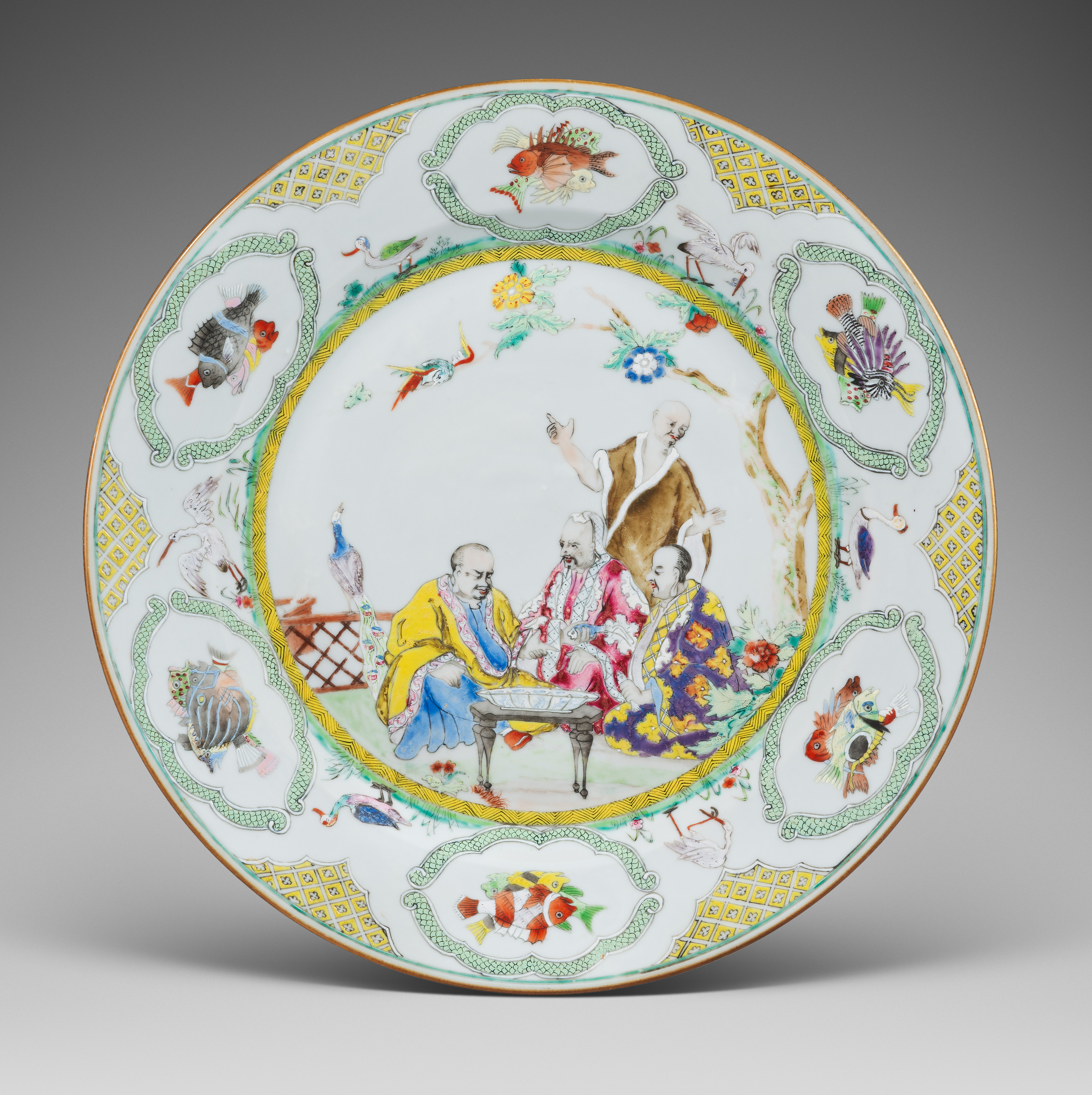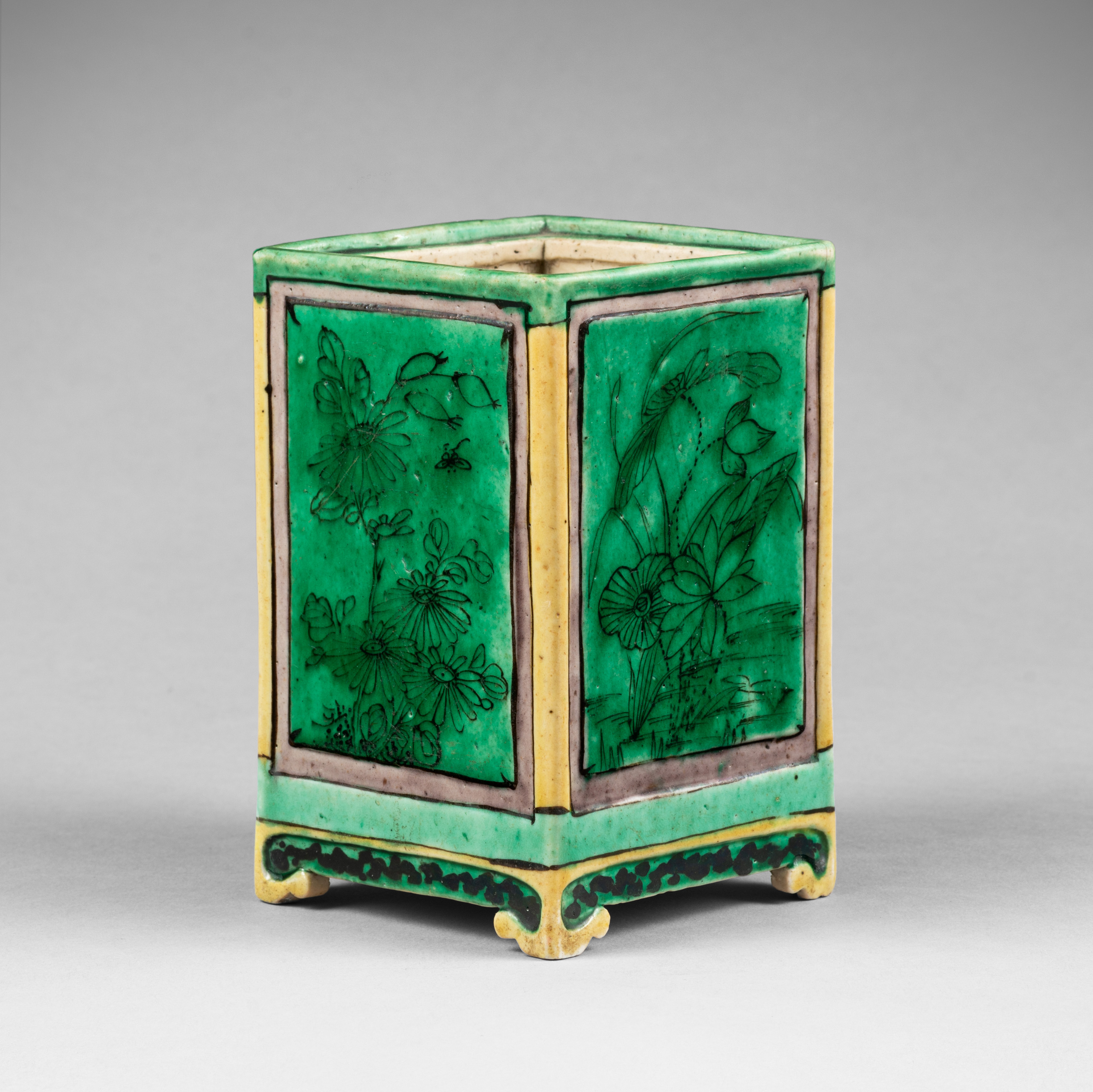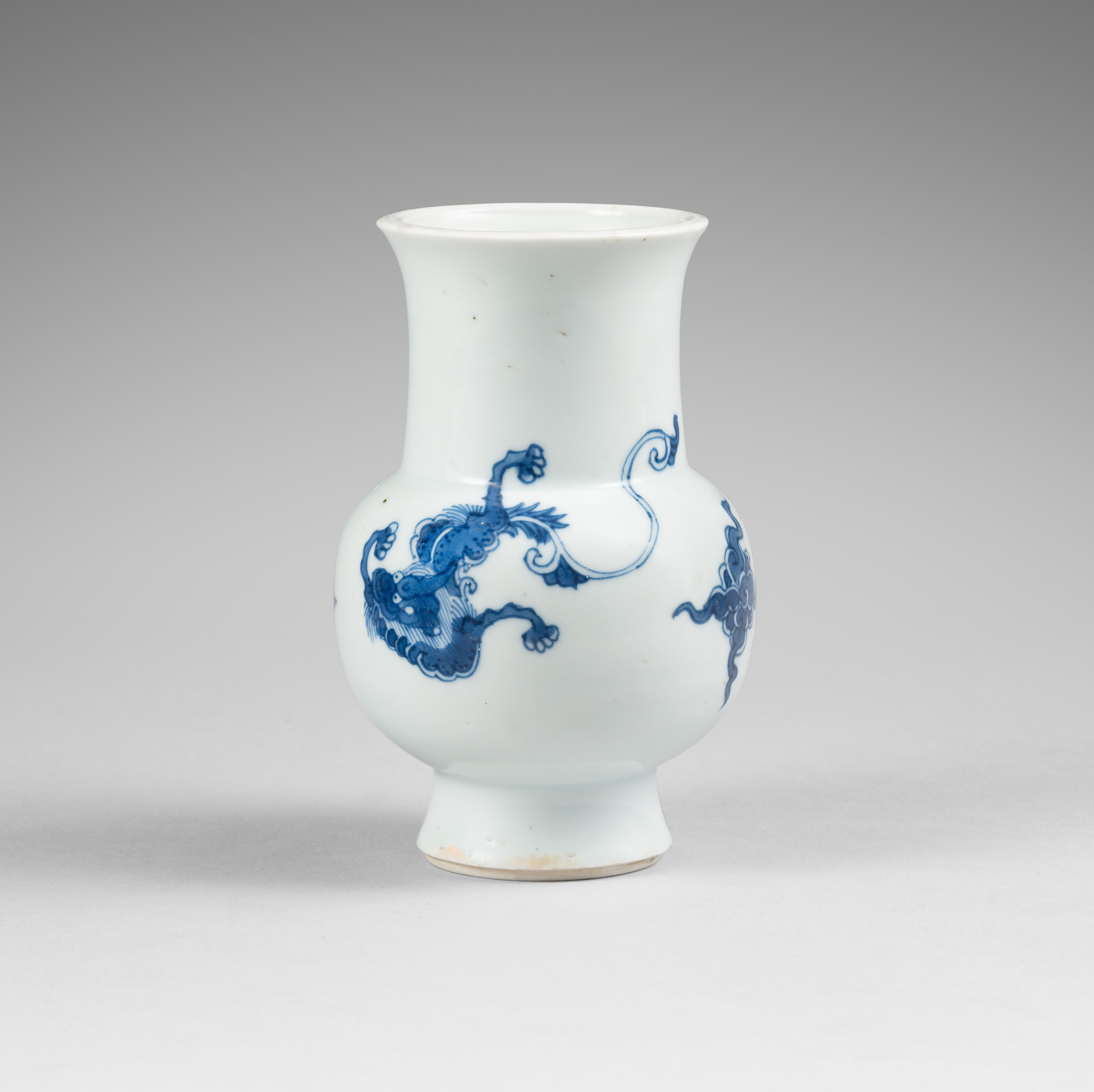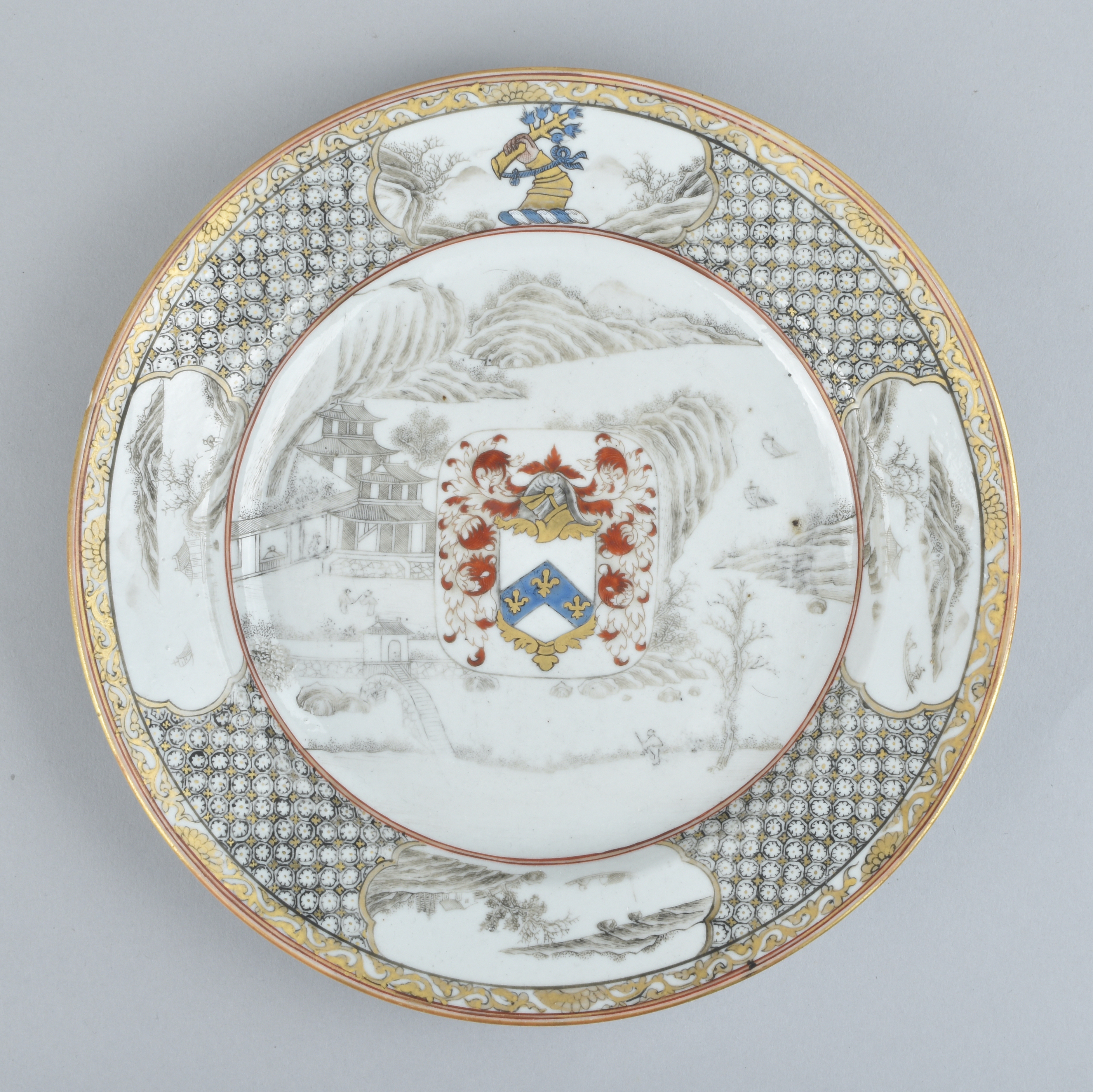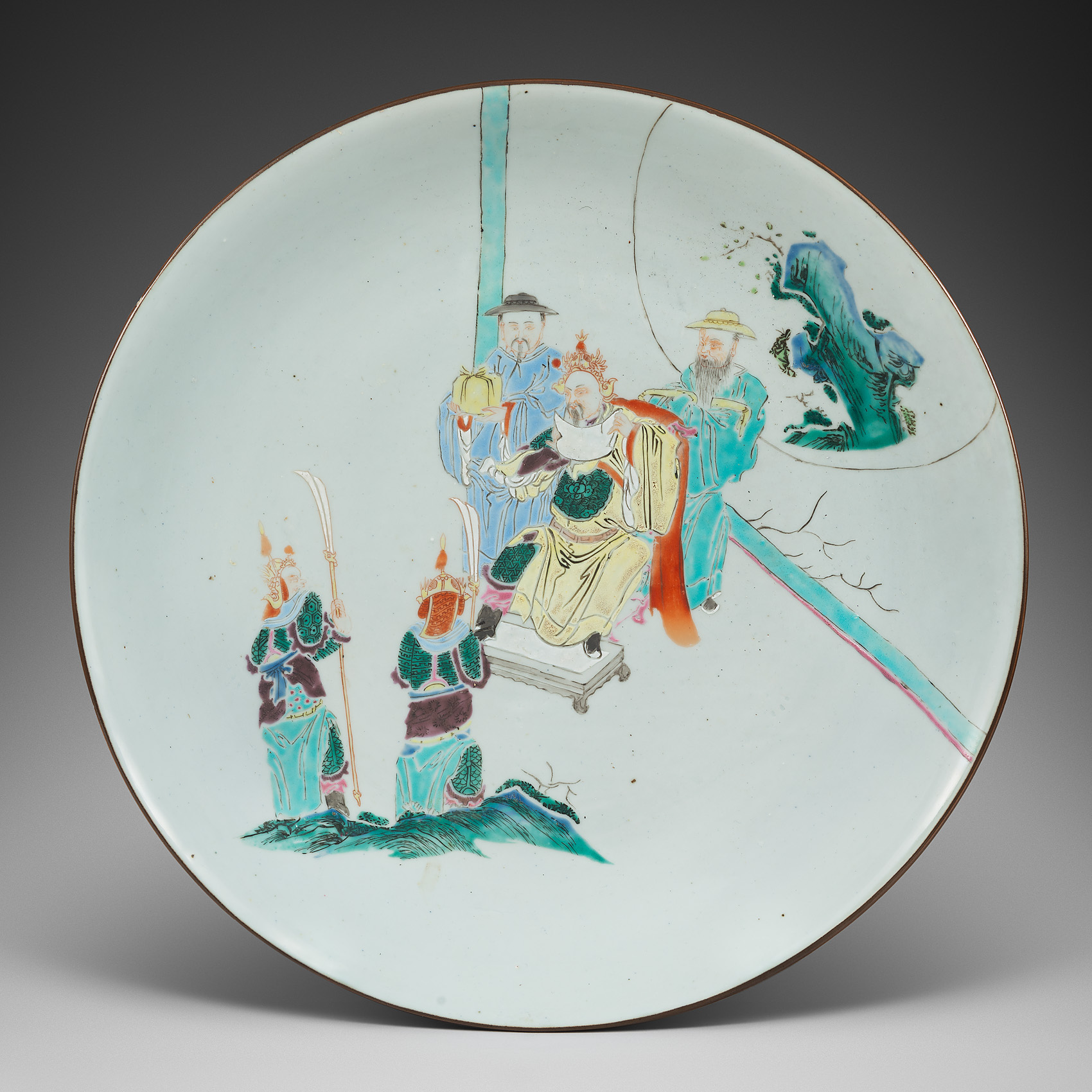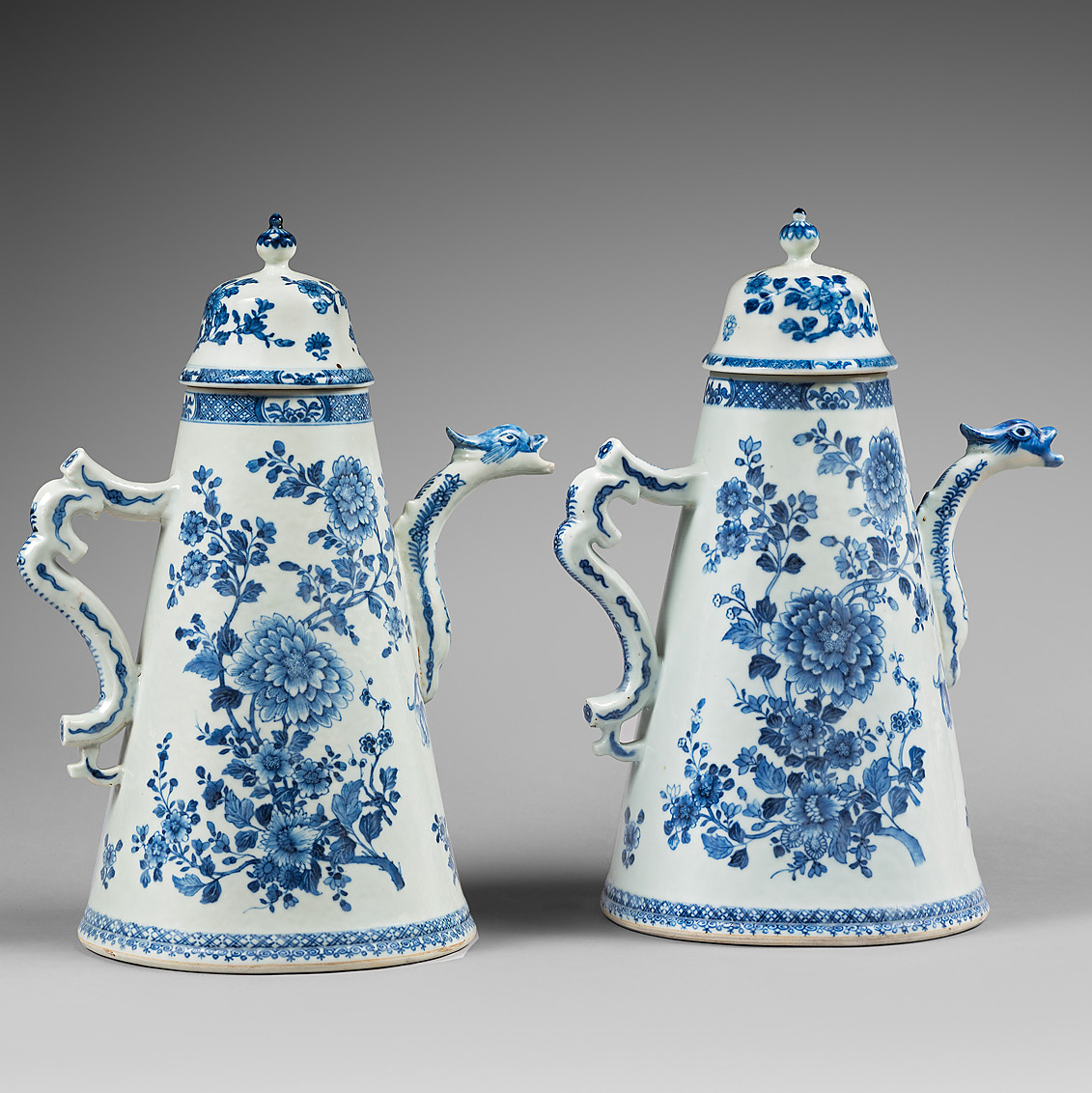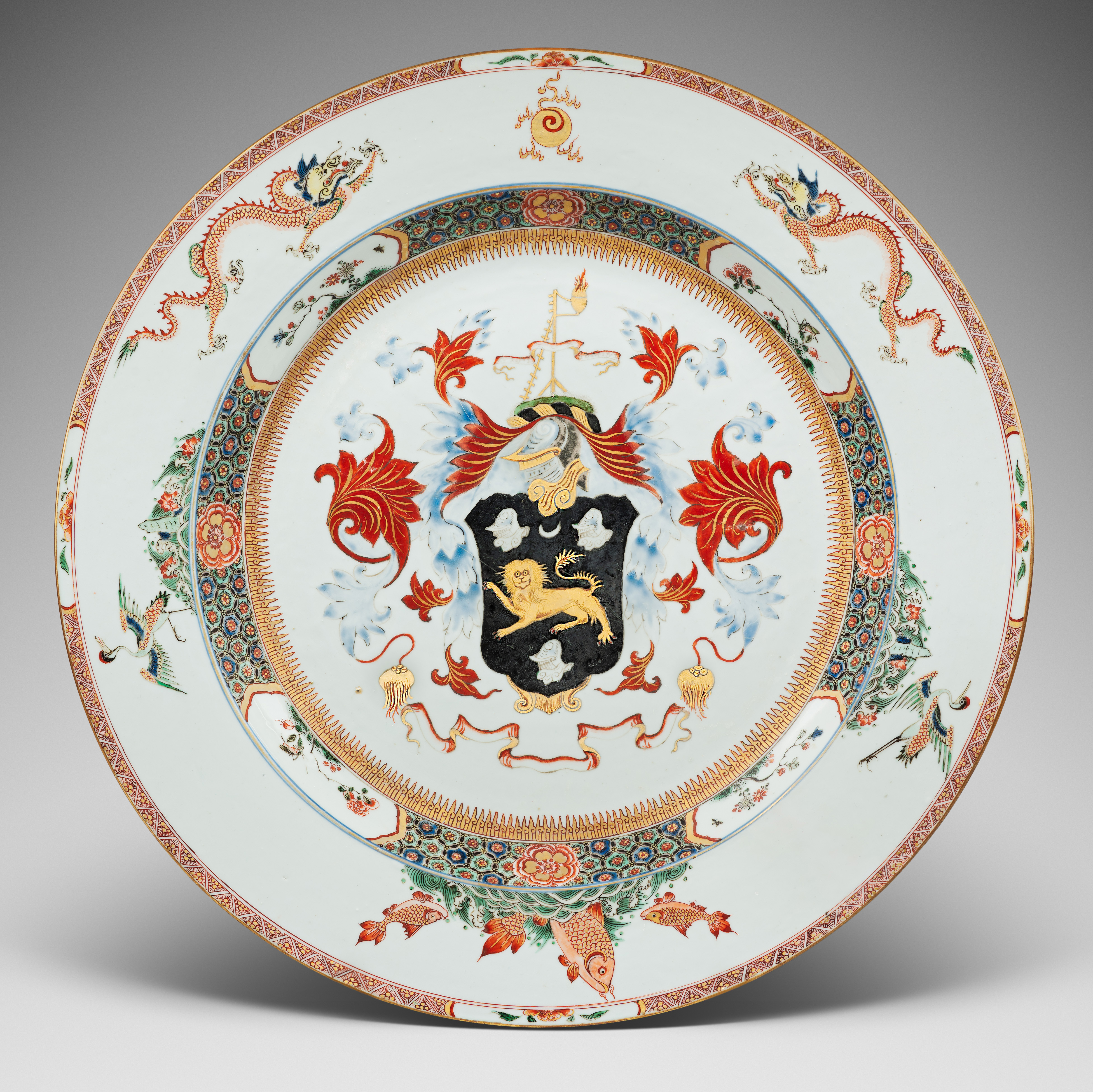
A massive Chinese armorial charger made for the Right Honourable Spencer Compton, Speaker of the House of Commons
Encircled by sinuous writhing dragons, leaping carp and other auspicious symbols of Chinese mythology, with a bold European coat of arms in baroque style which fills the centre, this magnificent charger decorated in Kangxi famille verte enamels is from perhaps the most visually dramatic of the first twenty armorial services made for the British market and dates to about 1715.
- Country:
- China
- Period :
- Kangxi (1662-1722), circa 1715
- Material:
- Porcelain
- Dimension:
- 18,70 in. (47,5 cm)
- Reference :
- D514
- Status:
- sold
Provenance
A private French collection
Notice
By Angela Howard
Director, Heirloom & Howard Ltd
In England, the earliest armorial tablewares ordered from China from about 1705 onwards were commissioned for East India Company governors, wealthy London merchants and investors, and for those with political influence at the highest levels of government. The politicians included Lord Somers, the Lord Chancellor; Sir Robert Walpole, Prime Minister; Sir William Pulteney, Leader of the Opposition to Walpole, and Spencer Compton, Speaker of the House of Commons.[1]
The arms are those of Compton, a family who had assumed their name from a Lordship of the Manor in Warwickshire before the twelfth century. The arms may be blazoned: Sable a lion passant gardant or, between three helmets argent, with a crescent for difference [the crescent denoting a second son]; with crest, On a mount vert a beacon or, enflamed on the top proper, on the beacon a label inscribed ‘Nisi Dominus’, a quotation taken from Psalm 127. These arms were borne by Spencer Compton (ca.1674-1743) of Compton Wynyates in Warwickshire, later Earl of Wilmington, the second surviving son of the 3rd Earl of Northampton.
The range of five-colour enamels known as wucai in China, and later named famille verte by the French author Albert Jaquemart, was enhanced in the second half of the Kangxi reign when it became increasingly sought after in Europe as well as popular in the domestic market. In the West, the translucent and glossy shades of green, with accents of red augmented now by blue and black enamels, worked well in fashionable and elegant interior settings with the new walnut furniture that was introduced into England from Europe in the 1680s. It supplanted the taste for blue and white, which had been the familiar accessory to the earlier oak surroundings, until it finally gave way in the early 1720s to the new opaque famille rose enamels. Although western forms were introduced, the classical Chinese decorative motifs on famille verte porcelain remained the same for the export market as they did for domestic demand.
Very few armorial wares were decorated in this palette. In the Dutch Republic, with the exception of the series with the arms of the Dutch provinces, only two sets were ordered by private individuals, both about 1700. In Britain (leaving aside two rare early single samples) just sixteen services with translucent enamels are recorded between 1710 and 1720, of which only eight include at the cavetto the traditional band of stylised famille verte lattice work punctuated by scenic vignettes, all dating to about 1715-20 and all varying slightly in actual design. Of these, the Compton service has perhaps the finest rim decoration. It illustrates the Chinese legend of golden carp fighting their way upstream in the spring until they reach the Dragon Gate waterfall (Longmen) on the mountain where those which are strong enough will leap over it to attain dragonhood—an analogy for young scholars who achieve success in their imperial examinations, and a symbol of courage, perseverance and accomplishment. Thus, on the lower rim of the dish three carp leap through turbulent foaming waves, while above a pair of four-clawed dragons (indicating the status of successful government officials) vie for the flaming pearl of wisdom at the apex. On the sides two red-crowned crane fly over rocky wetlands, furthering the metaphor of success and high rank in civic office, prosperity and longevity.
Despite a lack of direct evidence about the precise way these early orders were placed, and whether specific border designs could be requested (or indeed their meaning understood) at the point of ordering an armorial service for a prestigious client in China, the legend of the carp leaping the Dragon Gate into a successful career was remarkably appropriate for the Right Honourable Spencer Compton, for whom 1715 was a significant date in the advancement of his own political career.
Spencer Compton was born at Compton Wynyates about 1674 into a noted aristocratic family of royalists and politicians. His father, James Compton, 3rd Earl of Northampton, had fought for the king during the Civil War and had been rewarded with prestigious appointments by Charles II on his restoration to the monarchy in 1660. The young Spencer was only seven years old when his father died and his elder brother inherited all the estates. He was sent for schooling in London and Oxford, and was admitted into the Middle Temple to pursue a legal profession, with an inclination to enter politics; much as expected for a younger son. However, contrary to tradition in a family whose allegiances had always been to the Tories (the party of the Establishment that represented the Church, landowners and royal authority), he joined the Whig party—a new and progressive faction that promoted the supremacy of parliament and a constitutional (rather than absolute) monarchy. It was a wise decision as, at the commencement of the Hanoverian succession in 1714, the Whigs would take control of government and all offices of state for a period of over fifty years.
Compton entered parliament in 1698 and gradually established a circle of influential friends, including Lord Somers, the Lord Chancellor, and Robert Walpole, who in 1721 would become the first Prime Minister. From 1705 he held various appointments, including as Treasurer to Prince George of Denmark (consort of Queen Anne) but it was said that his skills lay in organisation and procedure rather than oratory. He was later described as ‘a plodding, heavy fellow with a great application but no talents’.[2] The Whig ascendancy following the accession of the Hanoverian George I, brought him the role of Speaker of the House of Commons in 1715 and hopes for rapid political advancement. However, his appointment the same year as Treasurer of the Household of the Prince of Wales (later George II) resulted in a long-lasting and bitter conflict with Walpole when relations between the king and the prince broke down. When George II succeeded his father in 1727 he tried, unsuccessfully, to make his treasurer prime minister, but Compton was outmanoeuvred by Walpole and his influence declined. As compensation (and to remove his rival from parliament) Walpole bestowed the title of Baron Wilmington on Compton in 1727, and then Earl of Wilmington three years later. In 1725 he had been installed a Knight of the Bath and in 1733 a Knight of the Garter.[3] Walpole’s long twenty-one-year period as prime minister finally came to an end in 1742 and Compton was again asked to form a government by the king. However, he was now 68 and his time in office was brief and undistinguished; he died the following year. Today his name lives on in the cities of Wilmington in Delaware and North Carolina, and townships of the same name in Massachusetts and Vermont.
A fine portrait was made of Spencer Compton about 1710 by Sir Godfrey Kneller which is now in the National Portrait Gallery, London (see illustration). This was for a set of so-called ‘Kit-Cat Club’ portraits, painted by Kneller between 1697 and 1721, for the political club of which he was also a member. This comprised a group of the most influential Whig politicians, landowners and men of letters of the day who pledged to ‘uphold the Glorious Revolution of 1688 and the Protestant Succession’[4]. The name came from Christopher (Kit) Cat’s tavern, where meetings were held and eponymous mutton pies consumed. The Memoirs of the Celebrated Persons composing the Kit-Cat Club (published 1821) report of Compton: “He was not distinguished for brilliancy of genius or eminence of abilities. His formal and solemn manner contributed to the support of his authority as Speaker, and seemed to denote extent of knowledge and profundity of thought …”, and on his appointment as Prime Minister and Chancellor of the Exchequer, “… which trusts he is said to have discharged with perfect integrity and honor.”
Although he eventually attained the office of prime minister, becoming only the second holder of that title, it might be said of Spencer Compton that he had already reached the heights both of his abilities and his profession during his tenure of Speaker of the House of Commons, a position to which he was unanimously elected in 1715 and held until his acceptance of a barony in 1727. The year of 1715 was indeed a time of great promise and ambition for him. Undoubtedly it would have been the ideal moment for ordering a magnificent service from China in the most fashionable style. Almost certainly only dishes and plates were ordered (as the case for several early services) and of these probably less than a dozen survive today, some still in family hands.
REFERENCES BIBLIOGRAPHY
Howard, David Sanctuary; Chinese Armorial Porcelain (1974), Style C3 (Famille Verte with diaper verte and noire), p.186. Illustrated from the Bullivant Collection, colour illustration p.117.
Howard, David S.; A Tale of Three Cities: Canton, Shanghai & Hong Kong (1997) No. 111, pp.96-97. A dish of 41.8 cm (16½ inches) loaned to the Sotheby exhibition by a private UK family collection.
Tudor-Craig, Sir Algernon; Armorial Porcelain of the Eighteenth Century (1925), pp.45 and 121, referring there to a 16½ inch dish which realised 36 guineas in the Crisp sale (Collection of Frederick Arthur Crisp, Puttick & Simpson, London, March 8-9, 1923, Lot 80) purchased by the private collector above; the same dish.
Crisp, Frederick Arthur; Armorial China: A Catalogue of Chinese Porcelain with Coats of Arms (privately printed 1907). The dish above, listed here as No. 880 but without measurements or illustration.
Jourdain, Margaret and R. Soame Jenyns; Chinese Export Art In the Eighteenth Century (first published Country Life, 1950; this edition 1967) p. 112. A dish of 47 cm (18½ inches) by descent to the Marquess of Northampton.
FOOTNOTES
[1] Both Lord Somers and Sir Robert Walpole ordered fine armorial services at the same time, about 1715, though both in the Chinese Imari palette, and Sir William Pulteney about five years later. See Howard, Chinese Armorial Porcelain (1974) p.177 for the Somers service and p.184 for the Pulteney service, and Chinese Armorial Porcelain Volume II (2003) p.134 for the Walpole service.
[2] Attributed to Lord John Hervey; John Ingamells, National Portrait Gallery: Later Stuart Portraits 1685–1714, National Portrait Gallery, London, 2009.
[3] The Garter was the senior Order of Chivalry with only 24 knights and in the gift of the monarch (although at that period often awarded for political favour).
[4] The events leading to the deposition of the catholic James II and the invitation by parliament to the protestant William of Orange and Mary Stuart to assume the crown.
Photography : Jérémie Beylard / Agence PHAR




















